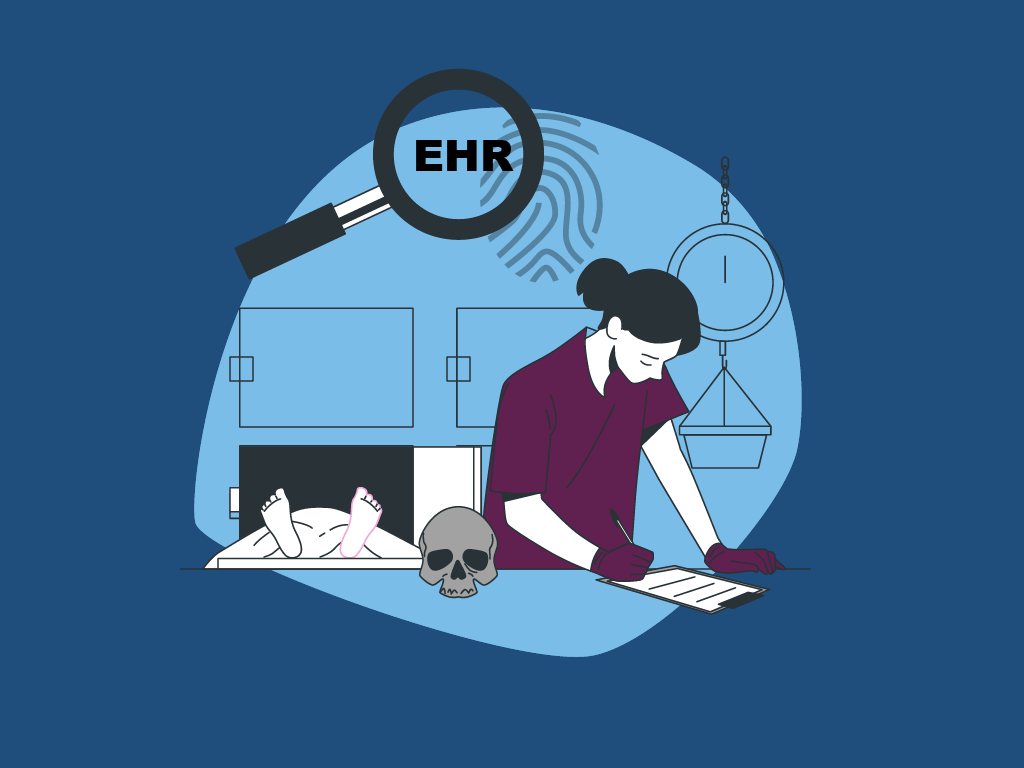Electronic Health Records (EHRs) are digital versions of clients’ paper records. They allow healthcare practitioners to view client records faster and quicker. A typical EHR contains details about the client’s medical history. It also contains treatment plans, medications and details that ensure clients receive personalized care. EHR implementation ensures that practices improve their effectiveness and time management. This software has portals that streamline administrative tasks. Due to this, health practitioners can focus on more important tasks such as providing better client support.
Several EHRs also provide telehealth services. With telehealth, rigidity is eliminated as health practitioners can hold sessions on the go. After the sessions, you can use the billing features to ensure payment is made promptly.
Step-by-Step Guide for Successful EHR Implementation
For a successful EHR implementation in your practice, consider the following step-by-step guide:
1. Establishing Clear Goals and Objectives
Setting clear goals and objectives is crucial for successful EHR implementation. Factors like the success metrics should be stated before the EHR implementation. Some success metrics to consider could include reduced wait time and improved billing accuracy. When setting the metrics, ensure it is specific, measurable, accurate, relevant, and time-bound.
It is also important to align the EHR goals with the needs of your practice. Looking into the needs of the different departments in your practice will help you spot these needs. With this knowledge, you will know the features and functionalities to search for in EHRs. It will help you to maximize the full benefits of the EHR system.
2. Assembling the Implementation Team
EHR implementation can be quite complex and demanding. To record a successful EHR implementation, practices need proper coordination and planning. One of the major steps in coordination is assembling the implementation team. This team will be responsible for anchoring the process and making pivotal decisions in EHR implementation.
As the team works on the EHR implementation, engage the stakeholders and end users. The stakeholders range from clinicians, administrative staff, IT and marketing staff. Stakeholders help reiterate the practice’s needs and provide needed direction. While, the end users will give valuable feedback. This feedback could prevent costly mistakes and ensure smooth EHR implementation.
Involving the team during transitions to the use of EHRs helps to address concerns that may arise. It also enables EHR system use training to be held in order to minimize resistance to change.
Core Team Members for the Implementation Team
- EHR Team Lead
The EHR Team Lead doubles as the project manager. They ensure the implementation is well coordinated.
- Clinical Team Lead
The clinical team lead is a representative of healthcare providers. They give care to clients and know what the team needs to get their job done effectively.
- IT Specialists
They manage the implementation of the IT infrastructure.
- Administrative Representatives
The admin team is responsible for tasks like scheduling appointments and billing. Their presence ensures that the management and finance aspect of implementing the EHR fit the practice’s needs.
3. Conducting a Needs Assessment
A needs assessment helps you understand how your practice is working right now. It shows what is going well and what needs to improve. You can see where the work process is slow or redundant. This helps you know what the EHR system should fix. If needed, you can make changes so the EHR fits better with your team’s existing workflow processes.
The process will also expose you to functions the EHR system needs to have to meet your practices’ clinical and administrative goals. During the assessment, you might observe the need for some technical functions. Some of these can include server capacity, network bandwidth, and data security protocols. Also look out for functions like customizable note templates, telehealth, e-prescribing, and client portals.
4. Budgeting and Resource Allocation
When planning for a successful EHR implementation, practices should have a budget. ****The budget should cut across the estimated cost for the implementation. Sometimes, practices plan for software licensing and forget details like hardware purchases and upgrades. Ensure to compare the estimated cost of implementation with the expected ROI. Having a detailed ROI analysis makes it easier to get stakeholder buy-in.
Sometimes, EHR implementation does not go as planned. Ensure to plan for contingencies like downtime, vendor delays, and data integrity issues. Also, allocate a part of the budget to staff training. Ensure your contingency budget takes about 10-20% of the entire budget. This will ensure that your practice can respond quickly if challenges occur.
5. Selecting the Right EHR System
Selecting the right EHR system will enhance productivity, and client care. However, a wrong EHR system could lead to frustration and costly setbacks. EHRs differ from one vendor to another, so you need a clear criterion for vendor evaluation. Confirm the vendor’s reputation, support system, and cost transparency. What are other customers saying about the vendor’s credibility? Reading reviews will help you shortlist the best vendors for your EHR implementation.
After curating a list of vendors, ensure to initiate a Request for Proposal (RFP) process. The RFP is a document that outlines the needs of the practice and invites vendors to submit proposals. The submitted proposals will capture reasons the vendor’s EHR meets the practices’ needs. It also outlines the project’s goals, functional requirements, and technical specifications. The document will also give detailed timelines and budget expectations.
6. Planning the Implementation Timeline
Having a clear implementation timeline guides the EHR implementation from planning to execution. One of the challenges in setting timelines is choosing between the phased and big bang approaches. Each method has its merits and demerits. However, the choice of approach depends on the practice’s size and risk tolerance.
Types of Implementation Timeline
- The Phased Approach
The phased approach rolls out the implementation in stages. It could either be done based on departments, location, or functionality. The major advantage of the phased approach is that it enhances smoother transition and reduces risk. In the phased transition, challenges can be spotted and resolved before the completion of the EHR implementation.
- The Big Bang Approach
The Big Bang approach involves complete implementation at once. This approach is best suited for small practices and well-coordinated practices. If there is an EHR software implementation error in the Big Bang approach, it could lead to downtimes that will affect the practice.
7. Data Migration and Integration
Proper data migration and integration ensures client data isn’t lost during EHR implementation. The first task in data migration is preparing the legacy data for transfer. During this phase, relevant data would be identified and formatted to fit the EHR’s system. Practices would also use the opportunity to identify relevant data and data that doesn’t need to be transferred.
After identifying relevant data, the selected data is cleaned, and standardized. Duplicate entries are cleaned up and correct data is transferred. During the transfer process, pay attention to data integrity and security. Data integrity ensures that the data is accurate, consistent, and complete.
Similarly, the security of the transferred data must be given attention. Practices should enforce strict access controls and ensure the EHR system is HIPAA compliant. To avoid mistakes, use third-party vendors with expertise in secure data migration.
8. System Configuration and Customization
System configuration and customization ensure the EHR aligns with the practice’s workflow. This might include modifying the EHR’s layout, templates, and scheduling outlook. That’s why it is best to opt for EHRs that support customization. These customizations ensure flexibility that makes the system cater to your practice’s needs effectively.
The EHRs will be hosting sensitive client data and information. As a practice, it is important to ensure staff only have access to the data they need to function. Ensure to set the user permissions and user control so that client data is safe. Also, use audit trails that specify who modifies client data and when the data is modified.
Reducing documentation friction during implementation:
As teams adapt to a new EHR, one helpful way to reduce workflow disruption is to generate high-quality notes in Mentalyc and use the Mentalyc Chrome Extension to insert them into the EHR in seconds. This allows clinicians to maintain strong documentation quality while still learning the new system—without copy-pasting, retyping, or fixing formatting. It keeps the EHR as the official system of record while giving staff a smoother transition during early implementation. Learn more about Mentalyc and install Mentalyc EHR extension here.
9. Training and Change Management
The success of the EHR implementation depends on the staff’s ability to use the system. Practices must develop comprehensive training programs that help therapists learn how to use the EHRs. The training should be structured, hands-on, and continuous. Aside from the initial orientation, have refresher courses. This will be helpful when the mental health practitioners start interacting with the system.
As you plan the migration to EHR, also prepare to face resistance. People resist change because of fear and a lack of confidence in the new system. Practices can manage this by incorporating clear communication channels. Ensure to explain the reasons for the change and highlight the benefits of using EHR systems.
10. Testing and Quality Assurance
The success of an EHR implementation cannot be ascertained without testing and quality assurance. As the practice migrates to the EHR system, perform a thorough system test. The system test will help confirm that all functions of the EHR are performing optimally. Similarly, conduct a User Acceptance Testing. During the test, simulate real world scenarios and have clinicians test the EHR system.
After the tests, collate feedback from the team. This feedback will help to address issues that were identified during the test. Ignoring user feedback could lead to workflow disruptions that would have serious consequences when the EHR is live.
11. Go-Live Preparation and Execution
At this phase, all planning, configuration, testing, and training should be drawing to a close. It is essential for the team to have a readiness checklist. This list ensures all vital tasks are completed before the EHR goes live. It also outlines the contingency plans if unexpected challenges show up.
Amidst the Go-live preparation and execution, there should be on-site support to aid in transitioning. The on-site team will assist with resolving glitches and answering questions that may arise. This support helps clear doubt and build the user’s confidence in the EHR system.
12. Post-Implementation Review and Optimization
A successful EHR implementation doesn’t end after the EHR goes live. The practice should have a post-implementation review to finetune the EHR system. Ensure to monitor the performance metrics at intervals. Performance metrics give the practice objective data to decipher the system’s performance. Some metrics to measure include patient throughput, error rates, and billing accuracy. You could also monitor the documentation times and user login frequency.
It is also important to get feedback from health practitioners using the EHRs. The practice could use surveys and suggestion boxes. Also, have post-implementation meetings to gather feedback. Feedback helps to make necessary adjustments and improve the performance of the EHR.
13. Compliance and Security Considerations
Ensuring HIPAA and regulatory compliance is essential for a successful EHR implementation. During the implementation, confirm that the EHR supports all safeguards specified by HIPAA. Ensure to look out for features like access control, audit logs, and user authentication protocols. Also confirm that stored and transmitted data are encrypted. This helps to avoid breaches that could result in legal problems and reputation damage.
Compliance ensures the EHR system meets the set regulatory requirements. However, you need to take active security measures to protect data from threats. It is best to have important security measures in place such as multi-factor authentication and security audits. Using role-based access control ensures you have a robust data backup and data recovery plan.
Conclusion
Successful EHR implementation is not just a technical upgrade. It is a transformation of your practice’s operations, care delivery and client engagement. Before you commence the process, you need a clear goal and a competent multidisciplinary team. You also need the buy-in of stakeholders and healthcare providers.
The implementation of the EHR is not a one-off process. After transition, you need to get feedback and constantly review the performance of the system. You can start your EHR implementation journey today by using Mentalyc’s free trial.
Mentalyc is an AI powered Note-taking App that assists with case management and automatic writing of progress notes. As your team begins implementation, Mentalyc can support your workflow by helping you generate high-quality notes and insert them into your EHR with the Mentalyc Chrome Extension—keeping documentation consistent while your staff adapts to the new system.
Frequently Asked Questions
1. How Long Does EHR Implementation Typically Take?
EHR implementation does not have a fixed timeline. It is influenced by factors like the scope of implementation, organization size, and data migration. On average, the implementation for smaller practices can take 30 days to 90 days. Larger practices EHR implementation could span 6 months to a year.
2. What are the Common EHR Implementation Challenges and How to FixThem?
It can be a bit daunting to transition from paper records to using an Electronic Health Record (EHR) system. Some people may not want to change how they work. Others may not get enough training to use the new system. Moving old data into the new system can also be a problem. It might even slow down the way your team works. To solve these problems, talk to your team early. Help them understand why the change is needed. Give them adequate training and ask for their ideas. Also, hire data experts to move the old records safely so no client information gets lost.
3. How Can a Private Practice Ensure Data Privacy and Security?
Give each staff a clear role and control what they can see or do based on their job. Use strong passwords or codes to keep data safe. Make sure all data is encrypted. Also, keep records of who checks or changes the data. This helps track everything and makes sure only the right personnel see the information.
4. What Support is Available Post-Implementation of an EHR System?
There are several supports available to practice post-implementation. Some of them include technical support, system updates, and patch management. The practice could also get support with training, performance monitoring, and customization.
References
Aguirre, R. R., Suarez, O., Fuentes, M., & Sanchez-Gonzalez, M. A. (2019). Electronic health record implementation: A review of resources and tools. Cureus, 11(9), e5649.
Ali, S. K., Khan, H., Shah, J., & Nadeem Ahmed, K. (2023). An electronic health record system implementation in a resource limited country—Lessons learned. Digital Health, 9, 20552076231203660.
HealthIT.gov. (n.d.). Electronic health records: Adopt, implement, and use summary.
National Institute of Standards and Technology. (2023). Securing electronic health records on mobile devices (NIST Special Publication 1800-24). U.S. Department of Commerce.
Reuters. (2025, March 14). Top 10 takeaways from new HIPAA Security Rule NPRM (2025).
Why other mental health professionals love Mentalyc

“For those who have hesitations … It is a lifesaver. It will change your life and you have more time to be present with your patients.”
Licensed Clinical Social Worker

“It immediately changed my quality of life, personally and professionally. I went from 3–4 hours a week of notes to 1 hour at most … that alone is invaluable personally and professionally.”
Owner/Independently Licensed Marriage & Family Therapist (IMFT)

“If I were recommending this software to a colleague, I would tell them that it is the best thing that they could do for their practice.”
Licensed Professional Counselor

“Do yourself a favor, make your life easier. Use the tools that are readily available … I found Mentalyc to be one of the best tools that I’ve ever used.”
Licensed Marriage and Family Therapist






